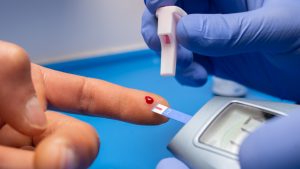Living with type 2 diabetes means making smart choices about what we eat. While it may seem like a daunting task, don’t worry! Here is a comprehensive guide to the foods you should avoid or limit if you have diabetes, along with their effects on your health and healthier vegan alternatives.

1. Added Sugars: The Silent Villains
Health Effects:
- Rapid blood sugar rise
- Insulin resistance
- Weight gain
Healthy Vegan Alternatives:
- Satisfy your sweet cravings with fresh fruits, like berries, apples, or oranges.
- Enjoy a plain vegan yogurt with a touch of vegan honey or pure maple syrup.
- Make a delicious fruit smoothie with plant-based milk (almond, soy, or coconut) and vegan protein powder.
2. Refined Grains: A Carb Bomb
Health Effects:
- Rapid blood sugar rise
- Reduced satiety
- Risk of heart disease
Healthy Vegan Alternatives:
- Replace refined grains with their whole-grain versions in your usual recipes, such as whole-wheat pasta, brown rice, or whole-wheat bread made with whole wheat or spelt flour.
- Experiment with alternatives like quinoa, oats, amaranth, or millet.
- Make homemade tortillas with whole-wheat corn flour or chickpea flour.
3. Saturated and Trans Fats: Enemies of the Heart
Health Effects:
- Increased LDL (“bad”) cholesterol
- Inflammation
Healthy Vegan Alternatives:
- Consume healthy fats like those found in extra virgin olive oil, avocados, nuts (walnuts, almonds, hazelnuts), and seeds (chia, flax, hemp).
- Choose tofu, tempeh, or seitan as sources of lean protein low in saturated fat.
- Enjoy delicious vegetable creams made with chickpeas, lentils, or beans.
4. Sodium: The Silent Enemy of Blood Pressure
Health Effects:
- High blood pressure
- Fluid retention
Healthy Vegan Alternatives:
- Limit processed foods and fast food, as they are often high in sodium.
- Cook your own meals with fresh ingredients and spices instead of salt.
- Opt for natural seasonings like aromatic herbs (basil, oregano, rosemary) and spices (black pepper, turmeric, cumin).
- Choose fresh fruits and vegetables, which are naturally low in sodium and rich in potassium, a mineral that helps control blood pressure.
Remember:
- Consult with a healthcare professional or a vegan nutritionist to get a personalized eating plan that suits your needs and preferences.
- Read nutrition labels carefully and choose products low in added sugars, refined grains, saturated and trans fats, and sodium.
- Enjoy a varied and colorful diet, rich in fruits, vegetables, legumes, whole grains, and nuts.
- Stay hydrated by drinking plenty of water throughout the day.
- Engage in regular physical activity to maintain a healthy weight and improve blood sugar control.
By making informed decisions about your diet, you can better manage your diabetes and enjoy a full and healthy life!
E4 Helps you:
E4 Diabetes Solutions offers an innovative continuous monitoring system and comprehensive program called E4 Alive, designed to empower people with type 2 diabetes to take control of their health.
E4 Alive provides a combination of tools and personalized support to help you:
- Manage your diet: E4 Alive offers resources and tools to help you create a healthy eating plan tailored to your individual needs.
- Embrace an active lifestyle: The E4 Alive program motivates and supports you in incorporating regular physical activity into your daily routine.
- Connect with a community: E4 Alive provides access to a community of people with type 2 diabetes who share experiences and offer mutual support.
By joining E4 Alive, individuals with type 2 diabetes can:
- Reduce their blood glucose levels
- Improve their long-term glycemic control
- Lower their risk of diabetes-related complications
- Enhance their overall quality of life
E4 Alive is an opportunity for those with type 2 diabetes to take charge of their health and live a fuller life.
To learn more about E4 Diabetes Solutions and the E4 Alive program, visit THIS PAGE.

Type 2 Diabetes: Is It Really Reversible?
A recent National Geographic article [link] explores how type 2 diabetes could be reversible with the right approaches. This condition, which affects millions of people worldwide, has long been considered a chronic and progressive disease. However, recent research challenges this perception and suggests that with lifestyle changes and the right approach, remission is possible. The

How Do GLP-1 Drugs Compare? A Breakdown of Ozempic, Mounjaro, and Trulicity
GLP-1 receptor agonists have revolutionized diabetes management, with drugs like Ozempic, Mounjaro, and Trulicity leading the market. But how do these medications compare in terms of effectiveness, side effects, and patient outcomes? Let’s explore their differences and what they mean for diabetes patients. Understanding GLP-1 Medications GLP-1 receptor agonists mimic a natural hormone that helps

Why Has Medicare Spending on Diabetes Medications Skyrocketed in 5 Years?
In the past five years, Medicare spending on diabetes medications has increased nearly fivefold, reaching $35.8 billion in 2023. This surge has been primarily driven by the growing use of GLP-1 drugs such as Ozempic, Mounjaro, and Trulicity. But what is behind this cost escalation, and how does it affect patients and the U.S. healthcare

The Gut Microbiota and Blood Sugar Control: A Hidden Connection
The human gut is home to trillions of bacteria that play a crucial role in digestion, immune function, and even metabolism. Recent research has revealed a fascinating link between the gut microbiota and blood sugar regulation, shedding light on how the balance of microbes in our intestines can influence diabetes risk and overall metabolic health.

The Dawn Phenomenon: Why Blood Sugar Rises While You Sleep
For many people with diabetes, waking up with high blood sugar levels can be frustrating—especially if they didn’t eat anything overnight. This early-morning spike in blood glucose is known as the Dawn Phenomenon, and it happens due to natural hormonal changes in the body. But why does it occur, and how can it be managed?

The Influence of Red Light on Blood: Can It Improve Diabetes?
Type 2 diabetes is a metabolic disease characterized by insulin resistance and elevated blood glucose levels. In the search for complementary alternatives to improve glycemic control, red light therapy has gained attention due to its potential to enhance circulation, reduce inflammation, and optimize cellular function. But what does science say about it? ✨ What is

